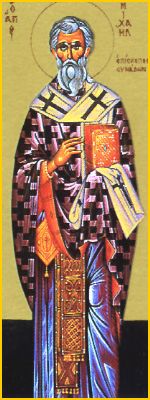
Feastday: May 23In an eleventh-century Byzantine book of saints known as the Menology of Basil, Michael is described as a "pious and God-fearing" monk. He was educated by the patriarch of Constantinople, Saint Tarasius, who at his accession to the episcopate had brought the Byzantine Church back to communion with the See of Rome after a six-decade schism. Tarasius sent Michael as the courier of a synodal letter to Pope Saint Leo III. In 787 Michael was consecrated bishop of Synnada (Turkey). Michael's defense of the veneration of religious images, in opposition to the Iconoclast heresy that condemned this traditional Christian practice, led to his suffering exile under the Iconoclast Byzantine emperor Leo V ("the Armenian"). Michael told the emperor, "I venerate the immaculate and divine image of our Savior and Lord, Jesus Christ, and of his most holy Mother." Michael spent the remainder of his life in exile at Eudokiadu (Turkey), dying there in 826.
Death: 826
Michael of Synnada or Michael the Confessor (Greek: Μιχαὴλ ὁ ὁμολογητής; died 23 May 826) was a metropolitan bishop of Synnada from 784/7 to 815. He represented Byzantium in diplomatic missions to Harun al-Rashid and Charlemagne. He was exiled by Emperor Leo V the Armenian because of his opposition to iconoclasm, and died on 23 May 826. He is honoured as a saint by the Orthodox and Roman Catholic churches, his feast day is May 23.
Life
Nothing is known about Michael's early life. He was much influenced by Tarasios (Patriarch of Constantinople in 784–806), who tonsured him. Tarasios sent Michael, along with Theophylact of Nicomedia, to him to a monastery that Tarasios himself had founded on the shores of the Bosporus. By 787, when he attended the Second Council of Nicaea, Michael was already metropolitan bishop of Synnada, having been named to the position by Tarasios. Michael is recorded in all sessions of the council.
He is commonly identified with the Michahel episcopus who was one of the leaders (along with Petrus abbas, identified with Peter of Goulaion) of an embassy sent by Emperor Nikephoros I to Charlemagne in 802/3, to ratify the peace treaty between the two. Nikephoros used Michael and Peter, along with Gregory, the steward of Amastris, again as peace envoys in 806, when the Abbasid caliph Harun al-Rashid launched a large-scale invasion of Asia Minor by the Abbasid caliph Harun al-Rashid.
In 811/2 he led another embassy to Charlemagne, along with the protospatharioi Arsaphios and Theognostos, on behalf of Michael I Rangabe, in order to renew the peace treaty and negotiate a possible marriage of Michael's son Theophylact and one of Charlemagne's daughters. Despite a warm reception at Aachen and the ratification of a peace treaty between the two realms, Charlemagne, perhaps wary after the repeated failures of successive efforts to that effect over the previous decades, hesitated to agree to such a match. On their way to Charlemagne's court, the embassy passed through Rome, where Michael handed over the synodika (enthronement letter) of Tarasios' successor, Patriarch Nikephoros I, to Pope Leo III.
He clashed with the Emperor Leo V the Armenian over Leo's re-adoption of iconoclasm in 815. He was arrested and exiled to Eudokias. He died there on 23 May 826.
Veneration
He is praised in the Synodikon of Orthodoxy of 843, and is venerated as a saint by the Orthodox and Catholic Churches on 23 May. He is invoked for protection of crops from pests.





